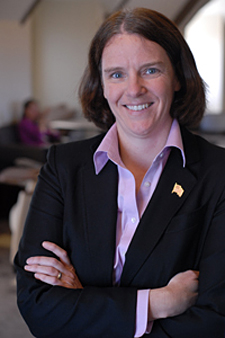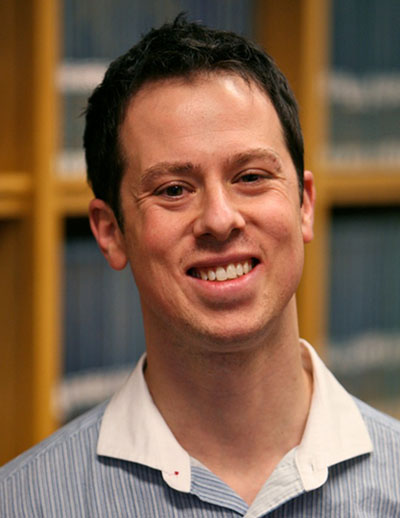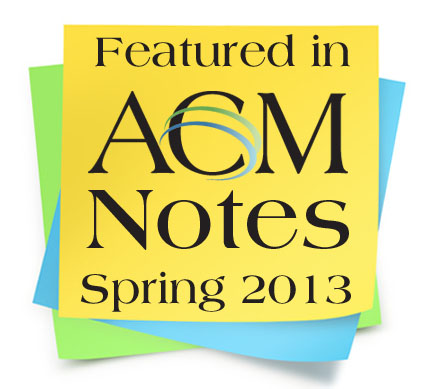“What would online courses mean for liberal arts colleges?” asked ACM President Christopher Welna. “Can we create online education that is distinctively liberal arts in its approach?”
Those questions, first posed by the presidents of the ACM colleges at a meeting last year, provided the impetus for a consortial Online Learning Initiative to develop and offer an online course this summer, according to Welna.
 Kristina Garrett
Kristina Garrett
The result is Calculus: A Modeling Approach, an applied mathematics course open to students at ACM colleges and aimed at social and natural science majors – such as economics, biology, environmental science, and psychology – who want to learn more about using quantitative tools in their disciplines.
A pair of mathematics professors – Kristina Garrett from St. Olaf College and Chad Topaz from Macalester College – have joined forces to develop and teach the course. Although offering a course completely online will be a first for them, both have been using innovative online elements to enrich their courses on campus.
Flipping for a learner-centered approach
When Topaz gives a lecture for one of his courses at Macalester, there’s usually not a student in sight. That’s because he teaches in the “flipped classroom” format, which upends the traditional way of delivering lectures.
Topaz pre-records his lectures – think of it as a podcast accompanied by slides illustrating the material he’s covering. Before going to class, students listen to the lecture, take short quizzes, and participate in discussions with their classmates, all online. The preparatory online work frees up the face-to-face time in the classroom for answering questions, doing problems, and small group work.
 Chad Topaz
Chad Topaz
Along the same lines, Garrett has been recording video lectures on the software and programming aspects of an upper level math course she’s teaching this semester. Students are enthusiastic about it, she noted, because they can study the lectures at their own speed, replaying sections when they need to. Since the students learn the programming skills they need from the video lectures, Garrett can spend more class time on the deeper material in the course.
“I think [the flipped classroom] is an extremely learner-centered model,” said Topaz. “The thing you gain when you pre-record material is that the time that’s spent with the instructor – whether that’s in a classroom at Macalester or St. Olaf or in online tutorials for our course this summer – is so much more valuable, because what we’re really doing then is addressing the needs of the individual learners. I think this model takes what we do at liberal arts colleges and does it even more.”
Applying math to “real world” problems
|
Calculus: A Modeling Approach |
| A pilot online course for students enrolled at ACM colleges. |
| June 17-August 9, 2013 |
|
| Visit the course webpage for information & to apply! |
In developing Calculus: A Modeling Approach, Topaz and Garrett have drawn on courses they teach on their own campuses. Though it’s a math course, it is not necessarily intended for math majors.
“We’re thinking of natural science and social science majors whose fields are really moving more and more toward understanding calculus concepts and using data to do that,” Garrett said. “They’ll learn how to think about problems in their field mathematically, computationally, and geometrically, and they’ll build some skills to deal with the problems that they see in their disciplines.”
Throughout the course, students will grapple with “real world” problems drawn from a variety of disciplines. As an example, Garrett cited current issues related to loans for college students. “We talk about rates of student debt increasing,” she said. “How fast are those rates increasing? Are they increasing faster than they used to? Those are all calculus questions. So [we will be] getting students to look at some timely data and ask appropriate questions. It gets them thinking about the right mathematics.”
“I always tell my students [that] life does not give you equations, nor does it tell you how to solve them,” Topaz noted. “The class is very much about challenging the students with open-ended problems, and giving them appropriate and modern tools to address those problems.”
Going face-to-face with online technology
Garrett and Topaz are organizing the course as week-long modules, each with a set of topics and learning goals. Typically, students will begin the week by studying the lecture materials and completing a brief “checkpoint” quiz to see if they understand basics of the material. An online discussion forum for the students is always open and the instructors will keep online “office hours.” A homework assignment and a unit quiz will be due at the end of each module.
A key component of the course will be weekly live video conferences. Students will have substantial face-to-face time with Topaz and Garrett during regularly-scheduled tutorials consisting of a professor and a small learning team of two or three students. All of the course elements, along with a cumulative final exam, will figure into the students’ grades.
At right: See a short sample from a lecture for the course.
To get all of the online interaction to work smoothly, Garrett and Topaz have relied on information technology specialists Barron Koralesky at Macalester and Nancy Aarsvold at St. Olaf. Their aim has been to select hardware and software that balances simplicity with functionality, while enabling the “high touch” aspects that are important to the course’s liberal arts approach. Since this is a pilot project for the consortium, the technical support team has kept an eye on integrating elements which are widely used across the ACM, such as Moodle and Google.
“Barron and Nancy have been absolutely amazing about getting us to think about the opportunities [the technology presents] and to move the project forward,” said Topaz. “We’re using technologies we haven’t used before, and they’re very exciting.”
“It’s incredibly fun,” Garrett added. “There’s a steep learning curve, but all [of the software is] easily accessible to our students and will provide them with some experience in mastering technology, which is great as they move into the job market. It helps them to build confidence.”
Seeking online experiences that meet students’ needs
Topaz and Garrett continue to develop the course, with feedback from an advisory committee of ACM faculty, and will work with Aarsvold and Koralesky to test all of the technical components this spring. Soon after, the course will start up its eight-week run from June 17-August 9. Students can apply for the course through the ACM website, with an application deadline of April 15.
David Schodt, the ACM Senior Program Officer who is involved with the Online Learning Initiative, noted that the value of this effort goes beyond the questions that sparked the project. “From this pilot, we’ll not only learn about online courses, but also learn about using online elements in ‘blended’ courses that combine classroom and web-based activities,” he said.
“This as a timely and important pilot project to do for the ACM,” said Garrett. “With online education exploding all over and the MOOCs [Massive Open Online Courses] kind of running away with the story, I think it’s important to think about what we do well at liberal arts colleges and how to translate that into some online experiences that can enhance the experience of our students and meet their needs.”
Links:
- Calculus: A Modeling Approach
- Faculty profiles: Kristina Garrett at St. Olaf College and Chad Topaz at Macalester College
- The Online Learning Initiative is funded in part by the ACM Faculty Career Enhancement (FaCE) project. FaCE is made possible by generous support from The Andrew W. Mellon Foundation.







